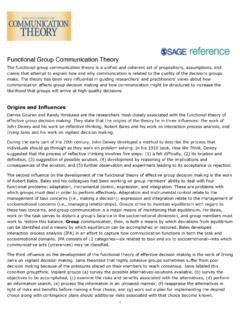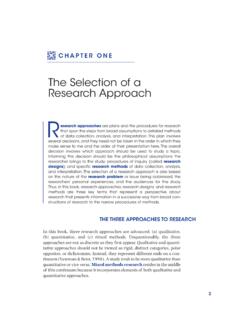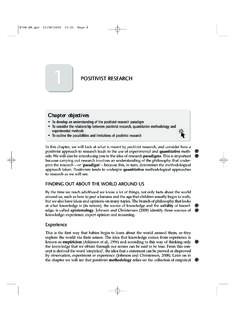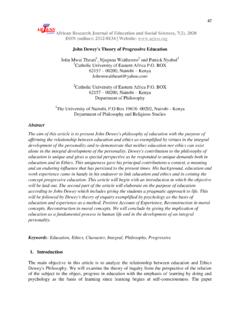Transcription of The Constant Comparative Analysis Method Outside of ...
1 The Qualitative Report2013 Volume 18, Article 1, 1-25 Constant Comparative Analysis Method Outside of Grounded TheorySheila M. FramIndependent Researcher and Consultant, Iowa City, Iowa USAThis commentary addresses the gap in the literature regarding discussion of the legitimate use of Constant Comparative Analysis Method (CCA) Outside of Grounded theory . The purpose is to show the strength of using CCA to maintain the emic perspective and how theoretical frameworks can maintain the etic perspective throughout the Analysis . My naturalistic inquiry model shows how conceptual frameworks and theoretical frameworks can be integrated when using the CCA Method . Keywords: Constant Comparison, Constant Comparative Analysis , Theoretical Framework, Conceptual Framework, Critical Discourse Analysis , naturalistic InquiryGrounded theory (GT) use has spread to various fields of study since Glaser and Strauss (1967) introduction of the methodology (Tan, 2010, p.)
2 94). A review of the literature on the Constant Comparative Method shows the same movement. CCA, as a technique or Method , appears to be considered as synonymous with GT. O Connor, Netting, and Thomas (2008) review of the GT literature shows a steady growth over the last several decades in the use of CCA within GT methodology. A review of dissertation abstracts from 2004 shows that GT is used in various ways. The authors highlight that 35% of the dissertations that state grounded theoryin their dissertation abstracts, keywords, and/or titles focus on the use of the CCA Method , but lack a definitive approach towards the development of a substantive theory . The problem appears to be a gap in the literature regarding discussion of the legitimate use of the CCA Method Outside of GT. The purpose of this commentary is to show the strength in using CCA to maintain the emic perspective (participant s view as insider) and how theoretical frameworks can maintain the etic perspective (outsider/ distant concepts) throughout the Analysis .
3 The commentary answers the question: What is the benefit of using CCA Method Outside of GT? Tan s (2010) review of the literature presents the question about the use of the terms methodology ( Allan, 2007; Glaser, 1992; Holton, 2007) and Method (Fendt & Sachs, 2008; Strauss & Corbin, 1990) surrounding the use of Grounded theory (GT). My understanding of the terms parallels Strauss and Corbin s (1998) definitions; methodology is a way of thinking about and studying social reality, (p. 3), whereas, Method is a set of procedures and techniques for gathering and analyzing data (p. 3). Tan s literature review clarifies that Glaser offers a methodological (paradigmatic) understanding; whereas, Strauss and Corbin offer a pragmatic understanding. My use of the terms in this commentary follows argument for the use of the CCA Method Outside of GT begins with a review of the literature to highlight CCA s origins, the shortcomings of CCA Method use in qualitative inquiry, and how the gap in the literature, along with a few recent adaptations of the CCA Method , shows some movement towards innovation, which is synonymous with a strong tradition of methodological innovation in qualitative research (Wiles, Pain, & Crow, 2010, p.)
4 3). Examples of how the Method has improved and how my model adapts and advances the use of the Method Outside of GT support the argument for the Qualitative Report2013A review of most recent journal articles located in ACADEMIC SEARCH ELITE and JSTOR and dissertations in DIA from 2000 to 2011 highlights a small number of articles discussing the use of CCA Outside of GT. O Connor et al. (2008) stated:It must be clear that Constant comparison, the data Analysis Method , does not in and of itself constitute a grounded theory design. Nor does the process of Constant comparison ensure the grounding of data whether grounding is used in a positivistic or interpretive sense. Simply put, Constant comparison assures that all data are systematically compared to all other data in the data set. This assures that all data produced will be analyzed rather than potentially disregarded on thematic grounds.
5 It is the time and the process of this Constant comparison that determines whether the Analysis is deductive and will produce a testable theory or whether the Analysis is inductive and will build a theory for a particular context. (p. 41)My argument substantiates O Connor et al. s claim that the Method does not constitute a grounded theory design, but that how the Method is adapted and used determines what methodology can support it. My model shows how the CCA Method can be adapted and supported by using a naturalistic Comparative Analysis : Emergence and Theoretical SensitivityGlaser and Strauss (1967) developed classical GT as an inductive approach to challenge the methodological restrictiveness of the hypothetico-deductive approach by allowing theory emerge from the organizing and reducing of data. Since classical GT, Glaser and Strauss have disagreed on the relationship between data and theory .
6 Efforts following the disagreement consisted of reconciling the significance of the diverging concepts of emergence and theoretical sensitivity (Kelle, 2005). Kelle (2005) goes on to suggest that novice attempts during open coding when using a CCA technique to allow categories to emerge from the data resulted in confusion and an overabundance of categories. Such attempts sparked issues of emergence. Glaser s and Strauss (1967) term, theoretical sensitivity, originally meant a deep well of theories or theoretical knowledge that a sociologist gains over time. Glaser (1978) attempted to explain through the use of theoretical codes how to engage theoretical sensitivity. Strauss (1987), with Corbin (1998), developed a coding paradigm; which was a structured theoretical coding process to follow when working with data during the axial coding step of their CCA Method .
7 Glaser asserted that the paradigm was an act of forcingthe data. Strauss and Corbin s paradigm works similarly to a conceptual framework and has demonstrated that it can serve as a useful guide to help novice researchers to reduce and reorganize a large amount of data. The authors disagree regarding what significance should be placed on theoretical sensitizing. Charmaz s Constructivist GT approach differs from Glaser s and Strauss approaches in that the focus is on a mutual construction of knowledge by the researcher and participant and the ability to develop subjective understandings of participants meaning (Charmaz, 2000, p. 510). Further, her approach focuses on how the researcher constructs Method and methodological strategies and requires accountability of the study s contexts and the researchers standpoint, priorities, and interactions (Bryant & Charmaz, 2007, p.)
8 10). Constructivist GT works to adapt and advance the CCA Method while still under the methodology of GT. Charmaz argues that classical GT localizes categories to data and ignores social reality relevant to the process of the logic of discovery. She argues that the classical GT stance is no longer tenable because of the establishment of Interpretivism, Symbolic Sheila M. Fram3 Interactionism, and other dominant theoretical perspectives in the social sciences. Her constructivist GT approach highlights the significance of distinguishing CCA as a Method that can be used with other methods . Shortcomings of EmergenceThe Constant Comparative Analysis Method is an iterative and inductive process of reducing the data through Constant recoding (Glaser & Strauss, 1967). Incidents or data are compared to other incidents or data during the process of coding.
9 This process begins with open coding to develop categories from the first round of data reduction and further reducing and recoding allows possible core categories to emerge (Charmaz, 2001; Glaser, 1978; Glaser & Strauss, 1967; Strauss, 1987). Originally, Glaser and Strauss (1967) referred to their coding efforts as a part of the Constant Comparative technique for generating theory under the framework of the GT Method (See also Glaser, 1965). Classical GT highlighted three types of Constant comparison: incident to incident, concepts emerging from further incidents in new data, and concept to concept (Glaser & Strauss, 1967). Later, Glaser (1978, 1992) more clearly defined the coding stages of CCA to include Substantive codingand Theoretical coding. Lincoln and Guba (1985) saw four distinct steps in Glaser s and Strauss comparison coding process: comparing incidents applicable to each category, integrating categories and their properties, delimiting the theory , and writing the theory (p.)
10 339). Strauss and Corbin (1990, 1998) offered a more fluid breakdown of CCA steps; which included open, axial, and selective coding. Their pragmatic approach showed novice researchers how to use the CCA Method and GT methodology. Many manuscripts show the use of CCA exclusively to infer a theory while positioning themselves within a GT methodology ( , Bencze & Bowen, 2009; Mishna, Newman, Daley & Solomon, 2009; Pignato, 2010; Randolph, 2010; Stillman, 2011). Elliott and Jordan (2010) broke down the Comparative process further stating: ..[CCA] begins by comparing incident to incident. But as it progresses, it is the increasingly abstract process of comparing concept to incident and concept to concept that further integrates It is through the process of comparing concept to incident that the researcher can check to see if further incidents fit with the newly developed concepts and, in so doing, ensure that the concepts are capable of accounting for all related incidents in the data.














